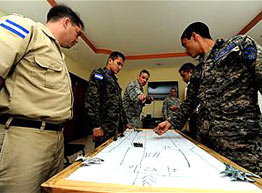
Tech. Sgt. Aaron Carrillo, a 571st Mobility Support Advisory Squadron air traffic control air advisor, explains the rules of ‘line up and wait’ to Honduran Air Force air traffic controllers during the third block of the ATC seminar Feb. 13, 2012, in Tegucigalpa, Honduras. Carrillo is in Honduras as part of a month-long building partner capacity mission. ‘Line up and wait’ is a term the air traffic controller uses when instructing a pilot to taxi onto a departure runway and wait for takeoff clearance. (U.S. Air Force photo/Tech. Sgt. Lesley Waters)
U.S. Air Advisors, Honduran Air Force Develop ATC Curriculum
The 571st Mobility Support Advisory Squadron and Honduran Air Force partnered together recently in developing an air traffic control technical curriculum for the Honduran Air Force air traffic controllers.
The 571st MSAS air advisors, part of the 615th Contingency Response Wing based out of Travis Air Force Base, California, USA, are participating in a month-long mutually beneficial forum for the exchange of ideas between U.S. and Honduran airmen via interactive seminars and hands-on applications here.
“The value of building partner capacity mission to the U.S. Air Force is priceless,” said Lt. Col. Joseph Sanchez, the 571st MSAS commander. “Not only will our air mobility experts hone their air advisory skills and receive certifications for this role, but they will also have the opportunity to learn new approaches to air mobility and exchange ideas with other Airmen who may have a different perspective.”
The entire ATC course covers 33 days of academic training and static scenarios. The subjects include ATC fundamentals, control tower fundamentals and practical application.
“I am working with three new ATC trainees who will forward deploy to the eastern portion of Honduras in the near future,” said Tech. Sgt. Aaron Carrillo, a 571st MSAS ATC air advisor. “I am also sharing my instruction techniques with the more experienced controllers, who in return are sharing with me their techniques.”
Carrillo has integrated English into the curriculum, since it is the required language in the international aviation world. During the practical applications, Carrillo shared ideas both in English and Spanish by using the terminology ATC controllers use on a daily basis, including “cleared for takeoff,” “go around” and “line up and wait.”
“I have an excellent interpreter in Staff Sgt. Angel Ortega, who is my safety net, but he allows me to actively learn the Spanish language,” Carrillo said.
Ortega, a 571st MSAS air transportation air advisor, works with Carrillo as his translator and said he has gained a better perspective of how the other career fields operate and affect his job.
“We are getting to know not only how the Honduran Air Force operates as a unit, but we are also working with its future leaders,” Ortega said. “As we continue working with Honduras and other Central and Latin American countries, we will continue building partnerships and forging friendships.”
The 571st MSAS is part of the Air Mobility Command’s Building Partner Capacity mission and supports 12th Air Force’s continued engagements in the U.S. Southern Command area of responsibility of Latin America and the Caribbean.
“Through the MSAS, we are able to build stronger international air force cooperation, interoperability and mutual support,” said Honduran Air Force Capt. Jose Ramon Tercero Aguilera, a radar maintenance officer. “When a crisis or contingency operation occurs in the future, we are better prepared to respond together.”
—-
Tech. Sgt. Lesley Waters
615th Contingency Response Wing Public Affairs / AFNS

You must be logged in to post a comment Login